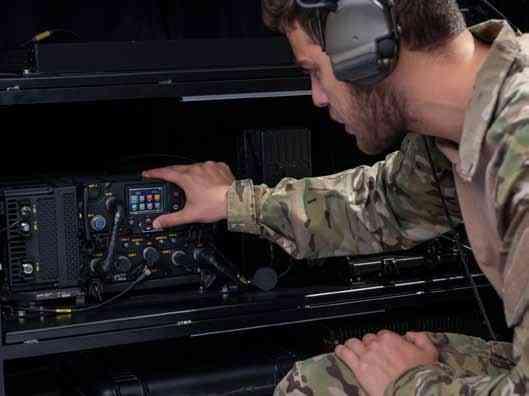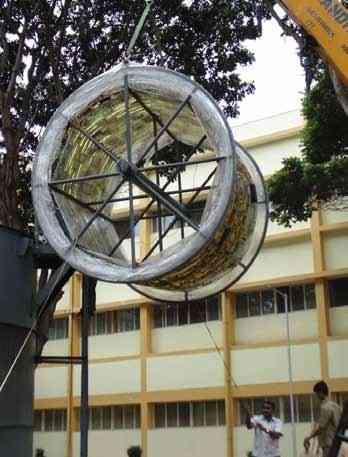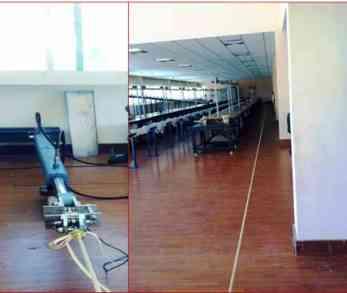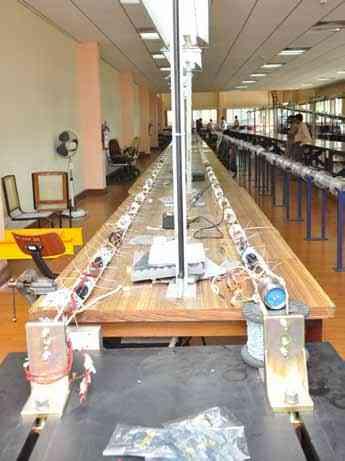
10 minute read
Flare Bright Wins Rapid Innovation DASA Contract
UK start-up, Flare Bright Ltd, won a UK Ministry of Defence (MOD) Defence and Security Accelerator (DASA) contract to rapidly innovate their SnapShot product.
SnapShot is a tiny, stealthy and fully autonomous nanodrone. It can fly in almost any weather or atmospheric conditions, and it isn’t affected by other electromagnetic signals or needs GPS to guide it. It can take high-quality aerial images with its hand-portable and extremely robust equipment. It is ballistically launched to a height of 100 metres then uses sophisticated and patent pending software to control a glide path and home to the user. Customer interest has been shown from law enforcement, emergency services, industrial inspection companies, urban mapping and the defence sector.
Advertisement
DASA’s Rapid Impact Innovations are viewed as those which will deliver a technology model or prototype demonstration at Technology Readiness Level (TRL) 6 or 7. This demonstration puts SnapShot in the hands of end users, and in the context or environment in which it is expected that the solution would be used.
In order to be funded, DASA assessed that the project would have a realistic prospect of achieving an impact within a 3-year time frame from its inception, and that there is a strong customer requirement and capability need for the idea.
To be successful Flare Bright had to provide evidence of how MOD and Security business and capability requirements, such as the Defence Lines of Development (DLOD), could be satisfied should the project to be taken forward after the pilot.
The contract is for £226,200 and will develop a soldierready robust prototype for testing with the Army.
To protect soldiers and fight the enemy, frontline soldiers need their own simple aerial surveillance that is lightweight and usable in any circumstance. The Army is keen to test out our technology at the frontline as soon as possible, as SnapShot delivers a simple, man-portable image-capture device that works whether GPS-denied or in jammed environments and in almost all-weather conditions. This is amply demonstrated by a Letter of Support from the Army Land Warfare Centre and winning a coveted space to demonstrate SnapShot at the Army Warfighting Experiment 2020 showcase. Snapshot uses autonomous flight software and has sufficient flight testing to be years ahead of anyone else in perfecting this technology.
This product uses Artificial Intelligence and complex software to create pinpoint delivery of small packages in all-weather and atmospheric conditions, even when GPSdenied or jammed in the most challenging environments. “We have had 10 years of software and AI development to reach the point of being confident to deliver true autonomy irrespective of weather or other challenging environments. We are expecting this to launch a new era of autonomy in drones,” says Flare Bright’s CEO, Kelvin Hamilton.
Flare Bright is the leading developer of fully autonomous drones and drone systems. It is a UK company founded by a team of successful entrepreneurs and engineers. Its key product, SnapShot, is an all-weather instant image capture drone used by defence, the emergency services and for industrial uses.
Flare Bright’s mission is to become a leading supplier and innovator of autonomous flight systems. Using SnapShot as our proving technology, we will build robust tech, engineering and manufacturing knowhow that creates products and services to supply the world’s growing aerospace autonomy sector.
Flare Bright has numerous Letters of Support from key customers, was a winner of Phase 1 of InnovateUK’s Future Flight competition and has been selected to be showcased on the Army Warfighting Experiment 2020.

Elbit Systems Awarded a $33 Mn. Contract to supply Radio Systems for an Army in Asia-Pacific
Elbit Systems Ltd. has been awarded a contract valued at approximately $33 million to supply tactical radio systems to a customer in Asia-Pacific. The contract will be performed over a 12-month period.
Under the contract the company will equip the customer’s Artillery and Infantry Forces with tactical radio systems including vehicular, man-packed and handheld configurations. The radio systems feature advanced networking capabilities enabling reliable and secure voice and data communication services over extended ranges. This contract award follows a recent decision by the customer to equip its Army with additional networked combat solutions from Elbit Systems, including E-LynX Software Defined Radios (SDR) and TORCH-X Command and Control systems.
Elbit Systems’ radio solutions have been selected by numerous Armed Forces around the world, including those of Switzerland, Sweden, Germany and Israel.
Elbit Systems Ltd. is an international high technology company engaged in a wide range of defense, homeland security and commercial programs throughout the world. The Company, which includes Elbit Systems and its subsidiaries, operates in the areas of aerospace, land, and naval systems, command, control, communications, computers, intelligence surveillance and reconnaissance (“C4ISR”), unmanned aircraft systems, advanced electrooptics, electro-optic space systems, EW suites, signal intelligence systems, data links and communications systems, radios, cyber-based systems and munitions. The Company also focuses on the upgrading of existing platforms, developing new technologies for defense, homeland security and commercial applications and providing a range of support services, including training and simulation systems.

MoD signs 409 Cr. contract with Indian company for Hand Grenades to Army
Providing further boost to the ‘Make in India’ initiative of Government of India in the Defence Sector, Acquisition Wing of Ministry of Defence (MoD) signed a contract with M/s Economic Explosive Ltd (EEL), (Solar Group) Nagpur for supply of 10,00,000 Multi Mode Hand Grenades to the Indian Army at an approximate cost of Rs. 409 Crores. These grenades will be replacing the hand grenade design of World War-II vintage, in use with the Indian Army.
The Multi-Mode Hand Grenade has been designed by DRDO andTerminal Ballistic Research Laboratories (TBRL) and is being produced by M/s EEL, Nagpur. The Grenades have a distinctive design, in that, they can be used in both Offensive and Defensive Modes. This is a flagship project showcasing public-private partnership under the aegis of DRDO & MoD enabling “AtmaNirbharta” in cutting edge ammunition technologies and accomplishes 100% Indigenous Content.
Five Startups Chosen by IAI’s Innovation Center

IAI’s unique accelerator track allows the startups to work with IAI’s technology leaders, realize long-term business potential, leverage breakthrough technologies, and gain access to IAI’s customers in
QuantLR, Aigent-tech, DST, Scopoli, and Fvmat are the five finalists chosen for the accelerated development track under a hybrid work model and will benefit from working with Israel Aerospace Industries (IAI) best technology experts. The five companies were selected out of hundreds of companies that expressed their interest in the accelerator and over 90 which applied to IAI’s Innovation Center. Following the shortlisting stage, which selected 17 companies, a steering committee consisting of IAI’s R&D and innovation managers, chose the projects that will join the specialized accelerated track.
The accelerator track, scheduled to open on November 1st will run for 13 weeks, and in will operate in a first-ofits-kind hybrid working model with IAI’s top tech experts to co-create a Minimum Viable Product (MVP). QuantLR will join IAI\ELTA Group’s experts in a quantum sensing project. Scopoli and the Systems, Missile and Space Group will co-develop a solution for tracking people and object in complex terrains. Aigent-tech will work with IAI\ELTA on AI for land applications. DST will collaborate with the Aviation Group in the creation of a real-time monitoring system, and Fvmat will develop an aircraft landing gear with the help of the engineers of the Aviation and Military Aircraft Group.
Amira Sharon, VP of R&D and Innovation at IAI, said, “In addition to choosing the five companies that will use IAI’s accelerator, we’ve established ties with multiple startups from a range of content areas. We are currently assessing our continued business relations with these companies based on relevance. The companies that were selected for the upcoming cohort at the accelerator will have an opportunity to validate and test their technology jointly with IAI experts and supportive environment and, at the same time, become exposed to unique technologies and cross-fertilizing work processes in diverse open innovation fields. The accelerator forms another layer in the broad range of new processes that IAI is implementing to foster a culture of innovation of disruptive technologies.”
IAI is an innovation and R&D-oriented company in the fields of aviation, satellites, missiles, intelligence, cyber, UAV’s, robotics, and more. Innovation is an integral part of IAI’s corporate culture. The company integrates creativity with open innovation managed together under the company’s R&D programs. IAI’s investment in R&D and innovation totals ~$900 per annum, across varied technologies.

S Anbuvelan takes over as CEO of HAL’s Helicopter Complex
SAnbuvelan has taken over as Chief Executive Officer (CEO) of HAL’s Helicopter Complex . Prior to this, he was heading the Helicopter Division as Executive Director.
“My focus will be to ensure quality products & services and timely delivery from Helicopter Complex”, said Mr Anbuvelan after taking the charge. Anbuvelan did his graduation in mechanical engineering from Alagappa Chettiar College of Engineering, Karaikudi, Tamil Nadu and holds a Post Graduate Degree of M Tech in Aircraft Production Engineering from IIT Madras. He also holds Post Graduate Diploma in Business Management from XIME, Bengaluru. He joined HAL as a management trainee (technical) in 1986 and has experience of 34 years in various key positions. Some of the highlights of his career so far include productionising ALH’s integrated transmission assembly, ramping up production of ALH gear boxes, reduction of snags during equipping of ALH, training & development of employees, quality improvements in ROH of Cheetah & Chetak helicopters at Barrackpore, streamlining of ALH production and implementation of latest technologies in the field of manufacturing & assembly of helicopter products.

BEL Upgrades ATDS Maareech Manufacturing Facility With an Eye on ‘Atmanirbhar Bharat’
Defence Minister Rajnath Singh, inaugurated the upgraded, state-of-theart Maareech Integration Facility of the Bharat Electronics Limited through Video Conference.
Gowtama M V, Chairman & Managing Director, (BEL), on the occasion gave a presentation to the minister on Advanced Torpedo Decoy System (ATDS) Maareech. This initiative of BEL is in accordance with the Prime Minister, Narendra Modi’s vision of an ‘Atmanirbhar Bharat’, a self-reliant nation.
ATDS Maareech is a fully indigenous system involving sensors and decoys developed jointly by DRDO labs, Naval Physical & Oceanographic Laboratory (NPOL) and Naval Science and Technological Laboratory (NSTL) and productionised by BEL. Two production grade systems manufactured by BEL have been installed and trial evaluated onboard INS Gomati and INS Ganga. The Indian Navy has awarded BEL a contract for Maareech systems.
Prior to the induction of ATDS Maareech, the Indian Navy had imported the system for 12 platforms. But now with the indigenous development of this system, BEL has upgraded its existing facilities with capacity to manufacture and deliver 12 ATDS Maareech systems every year. This facility enables BEL to provide a reliable defence mechanism for Surface Ships of the Indian Navy against possible torpedo attacks.
The upgraded ATDS facilities include Test Bays for electronic cabinets, Expendable Decoy Manufacturing and Towed Array Integration & Testing facility (Ramp Structure, Oil Filling facility, Load Test facility and Neutral Buoyancy Tank facility). BEL has constructed a new building for ATDS manufacturing at a cost of around Rs.12 Crores. The indigenously developed Maareech System is a big step towards ‘Atmanirbhar Bharat’, as it saves the country around USD 4 Million in foreign exchange per system.

















